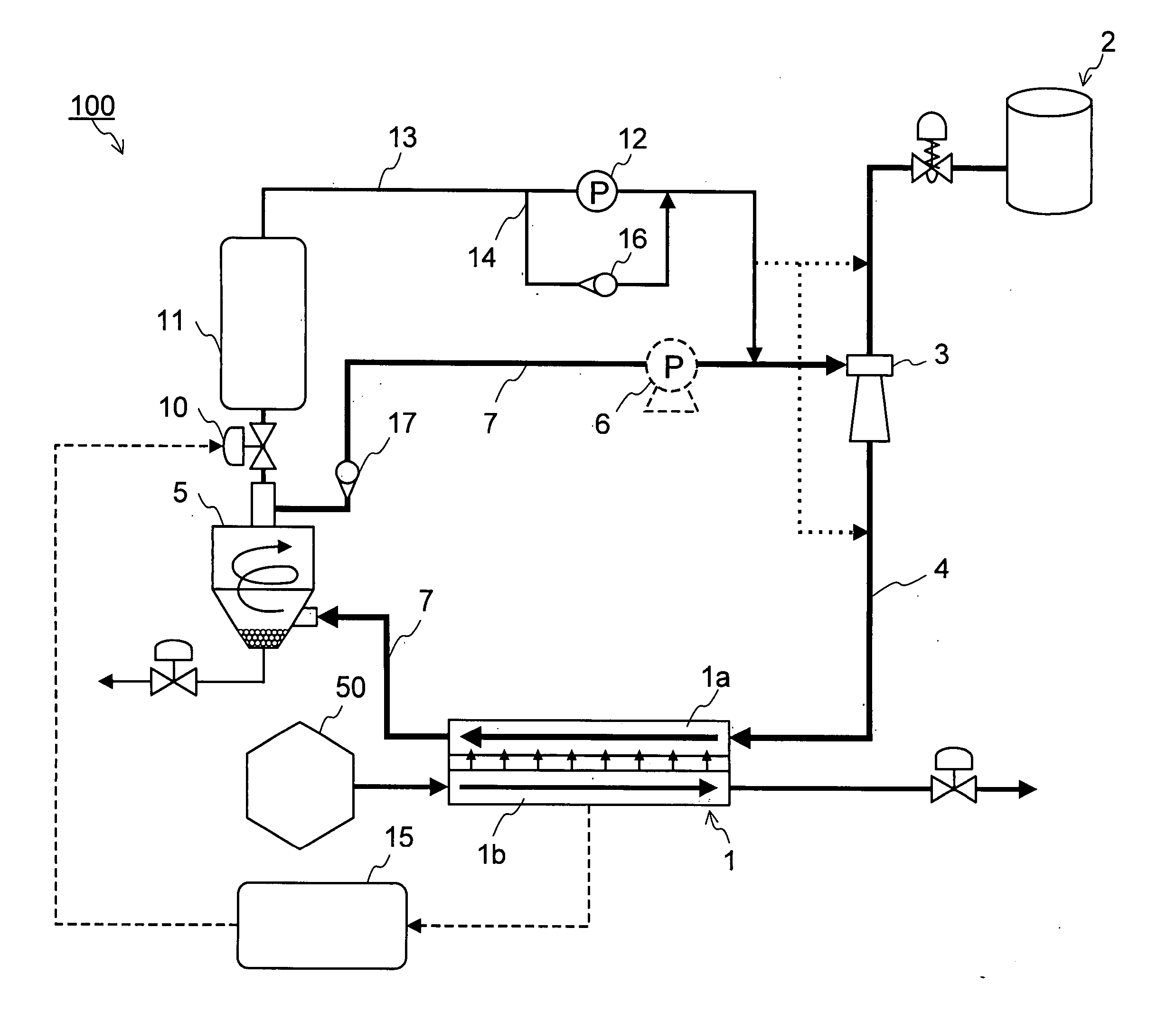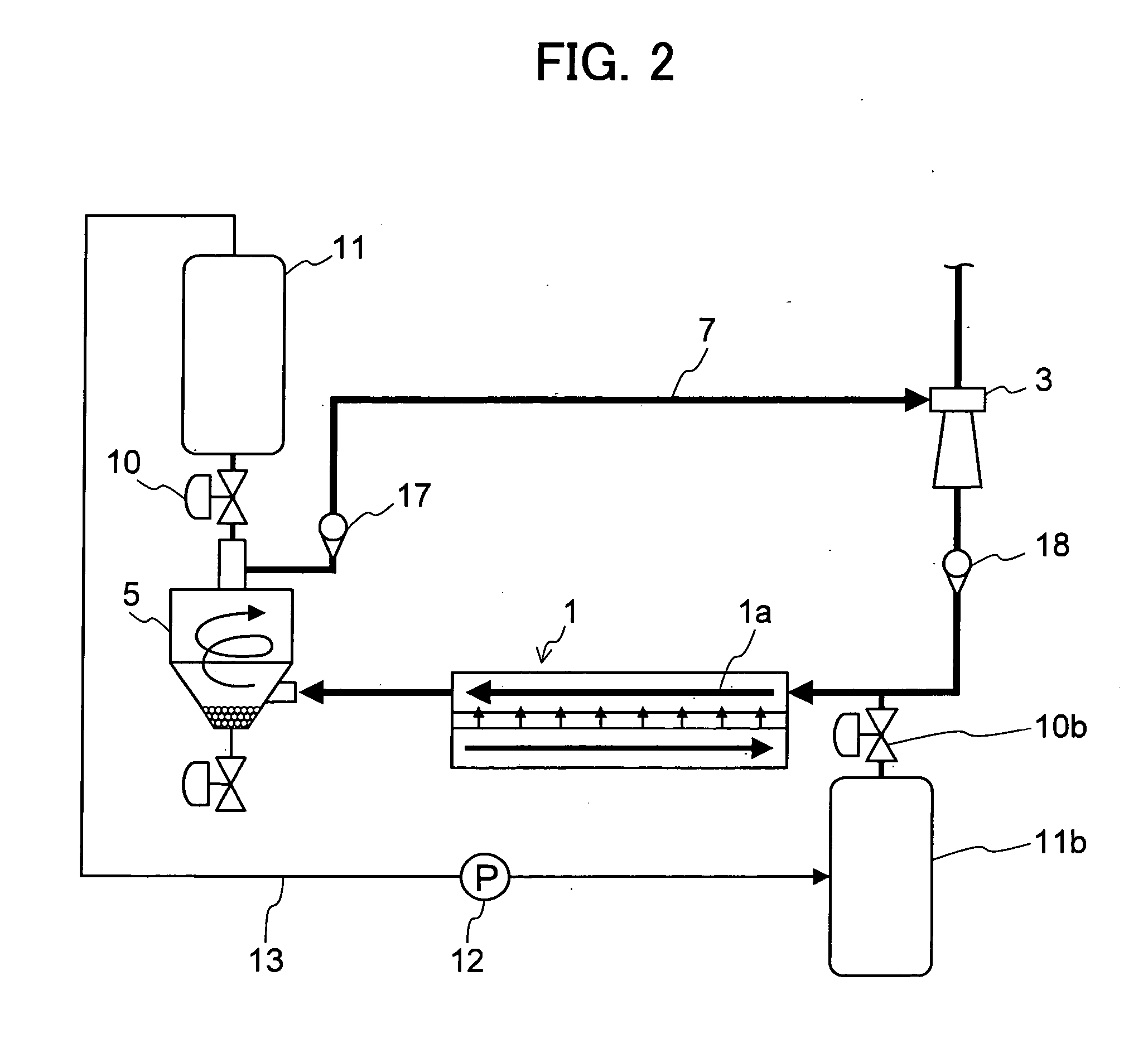Fuel cell system
- Summary
- Abstract
- Description
- Claims
- Application Information
AI Technical Summary
Benefits of technology
Problems solved by technology
Method used
Image
Examples
first embodiment
[0039] As shown in FIG. 1. the fuel cell system 100 according to the first embodiment of the present invention includes: a fuel cell 1; a supply channel 4 in which are disposed a fuel supply device 2 and an ejector pump 3; a circulation channel 7 in which are disposed a gas-liquid separator 5 and a circulation pump 6; an exhaust gas recovery channel 13 in which are disposed a first control valve 10, a first exhaust gas storage container 11, and a exhaust gas recovery pump 12; a bypass channel 14 which circumvents the exhaust gas recovery pump 12 of the exhaust gas recovery channel 13; and a control device (ECU) 15. Also, the circulation channel 7 and bypass channel 14 have check valves 16 and 17 provided. Note that the circulation pump 6 is not indispensable in the event that the ejector pump 3 is used.
[0040] The fuel cell 1 has a configuration in which a polymer electrolyte membrane formed of a cation-exchange membrane or the like is held between an anode electrode (fuel electrode...
second embodiment
[0053] The first embodiment described an arrangement in which the exhaust gas recovery channel 13 includes the first exhaust gas storage container 11 in a negative pressure state. According to a second embodiment, a second exhaust gas storage container 11b is provided to the exhaust gas recovery channel 13, in addition to the first exhaust gas storage container 11, as shown in FIG. 2. That is to say, with the second embodiment, the exhaust gas recovery channel 13 has the first control valve 10, the first exhaust gas storage container 11, the exhaust gas recovery pump 12, the second exhaust gas storage container 11b, and a second control valve 10b, which are disposed thereat in that order along the direction of gas flow. Also, one side of the exhaust gas recovery channel 13 is connected to the gas-liquid separator 5, while the other side of the exhaust gas recovery channel 13 is connected to the supply channel 4 which in turn is connected to the anode channel 1a of the fuel cell 1.
[...
third embodiment
[0057] The first embodiment described an arrangement in which the exhaust gas recovery pump 12 is provided to the exhaust gas recovery channel 13. According to a third embodiment, an electrochemical hydrogen pump 20 may be disposed at the exhaust gas recovery channel 13, as shown in FIG. 3. The electrochemical hydrogen pump 20 is a pump having an electrolytic membrane therewithin, having functions to separate gas using a property in which only hydrogen molecules pass through the electrolytic membrane (see FIG. 5). That is to say, with the third embodiment, the exhaust gas recovery channel 13 has the first control valve 10, the first exhaust gas storage container 11, the electrochemical hydrogen pump 20, and a check valve 21 disposed thereat, in that order along the direction of gas flow. Also, one side of the exhaust gas recovery channel 13 is connected to the gas-liquid separator 5, while the other end may be connected to either the circulation channel 7 or the supply channel 4. No...
PUM
 Login to View More
Login to View More Abstract
Description
Claims
Application Information
 Login to View More
Login to View More - R&D
- Intellectual Property
- Life Sciences
- Materials
- Tech Scout
- Unparalleled Data Quality
- Higher Quality Content
- 60% Fewer Hallucinations
Browse by: Latest US Patents, China's latest patents, Technical Efficacy Thesaurus, Application Domain, Technology Topic, Popular Technical Reports.
© 2025 PatSnap. All rights reserved.Legal|Privacy policy|Modern Slavery Act Transparency Statement|Sitemap|About US| Contact US: help@patsnap.com



